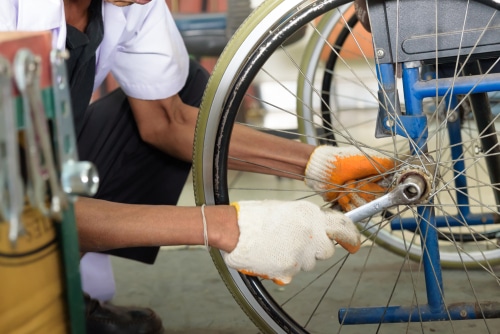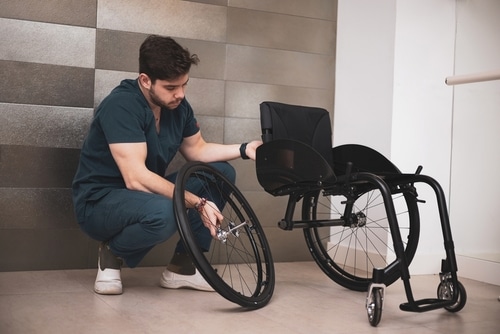With World Wheelchair Day coming up on 1 March, we’re putting the spotlight on this incredible piece of mobility equipment that’s a lifeline for many. However, as incredible as they are, like any frequently used equipment they don’t last forever. The question of “How long do wheelchairs last?” is important to answer for users and caregivers alike, as it affects budgeting, maintenance plans and, ultimately, your comfort and safety.
This blog post aims to delve into the various factors that determine the lifespan of a wheelchair, including the differences between manual and electric models, the impact of servicing it, and tips for extending the life of this essential equipment.
In this article

How long do wheelchairs last?
The lifespan of a wheelchair depends on several factors, including its type (manual or electric), the quality of its construction, how well it’s maintained, and how frequently it’s used. Here’s a general overview:
Manual
High quality manual wheelchairs can last between 5 to 10 years or more when properly maintained. The lifespan can vary based on the materials used (e.g., steel, aluminium, titanium), the environment in which it’s used (indoor vs. outdoor, smooth vs. rough terrain), and the level of care it receives.
Electric
Electric wheelchairs typically have a shorter lifespan than manual ones, often ranging from 3 to 5 years. This is partly because the electrical components and batteries wear out or become less efficient over time.

Factors affecting lifespan
Many factors affect your chair’s lifespan, however these are the key ones to pay close attention to:
- Usage: Frequent use, especially over rough terrain, can wear out a wheelchair faster.
- Maintenance: Regular cleaning, proper storage, and timely repairs can significantly extend a wheelchair’s life.
- Weight capacity: Consistently exceeding the wheelchair’s weight capacity can lead to faster wear and tear.
- Storage: Storing the wheelchair in a dry, clean environment can prevent rust and corrosion.
- Replacing parts: Parts like wheels, cushions, armrests, or batteries for electric wheelchairs can sometimes extend the useful life of the chair beyond the average lifespan.
How to extend your wheelchair’s lifespan
One of the best things you can learn this World Wheelchair Day is how to ensure your mobility equipment lasts. We’ve got an article on how to maintain your wheelchair or mobility scooter that you can check out, or you can read our summary below.
For all wheelchairs
Here are some top tips that will help you nurture the lifespan of both electric and manual wheelchairs:
- Regular maintenance and inspections:
- Do regular inspections for signs of wear and tear, including checking the wheels, tyres, brakes, and frame for any damage or unusual wear.
- Tighten any loose screws or bolts and make adjustments as necessary to avoid strain on the wheelchair components.
- Cleaning:
- Clean the wheelchair regularly with mild soap and water, focusing on removing dirt and grime from moving parts. Read our guide on how to clean your wheelchair.
- Dry the wheelchair thoroughly after cleaning to prevent rust and corrosion, especially if it’s been exposed to rain or moisture.
- Proper storage:
- Store the wheelchair in a dry, clean area away from direct sunlight and extreme temperatures to prevent damage to the materials and electronic components (for electric wheelchairs).
- Use according to manufacturer’s recommendations:
- Adhere to the manufacturer’s guidelines for usage, weight limits, and care to prevent undue stress and damage.
- Professional servicing:
- Have the wheelchair serviced regularly by a professional, especially for complex components like the electric system in power wheelchairs.

Manual
Be extra careful with these when it comes to your manual wheelchair:
- Wheel and tyre maintenance:
- Check the tyres regularly for proper inflation (for pneumatic tyres) and replace them if they’re worn out or damaged.
- Lubricate the wheel bearings periodically to ensure smooth rolling.
- Seat care:
- Inspect the seat and backrest for signs of wear or damage. Clean fabric parts according to the manufacturer’s instructions and check for any loose stitching or tears.
Electric
Pay close attention to these with your electric chair:
- Battery care:
- Charge the batteries according to the manufacturer’s instructions. Avoid overcharging or letting the battery drain completely.
- Store the batteries in a cool, dry place and avoid exposing them to extreme temperatures.
- Electrical components:
- Check the joystick and control panel regularly for signs of wear. Keep them clean and dry.
- Inspect the connectors and cables for any signs of damage or corrosion and address any issues promptly.
- Motor maintenance:
- While the motor itself may require little to no daily maintenance, be aware of any changes in performance or unusual noises, which could indicate a need for professional servicing.
General tips
In addition to all our tips above, also be aware of:
- Customisation and upgrades: Consider upgrading parts like cushions for better support and comfort, or wheels for better performance or durability.
- Education: Educate yourself and any caregivers on the proper use, maintenance, and handling of the chair to avoid accidental damage.
By following these guidelines, you can significantly extend the lifespan of you chairs, ensuring it remains a reliable aid in your daily life.

Protect your chair this World Wheelchair Day and beyond
This World Wheelchair Day, it’s time to protect one of the most valuable parts of your independence.
While there are excellent ways to prolong your wheelchair’s lifespan, accidents can happen that cause damage. Everyday obstacles like uneven footpaths, pedestrians, cyclists, road crossings and driveways can create dangerous situations that puts your mobility equipment at risk.
This is why Blue Badge Insurance has created a series of unique features and benefits in our policy specifically for mobility equipment users. This includes covering third party injury and property damage, loss or damage to the chair by theft, fire, flood or vandalism, and the costs to get you and your equipment home after an accident.
You can find out more here on our insurance pages – Wheelchair Insurance and Mobility Scooter Insurance.








